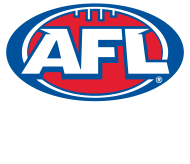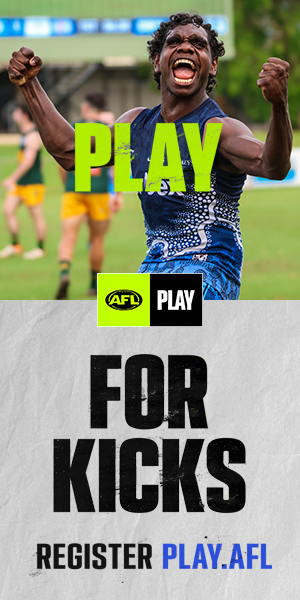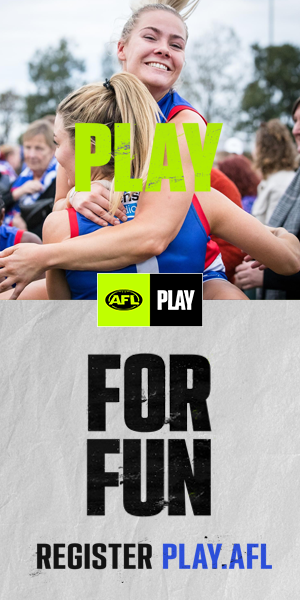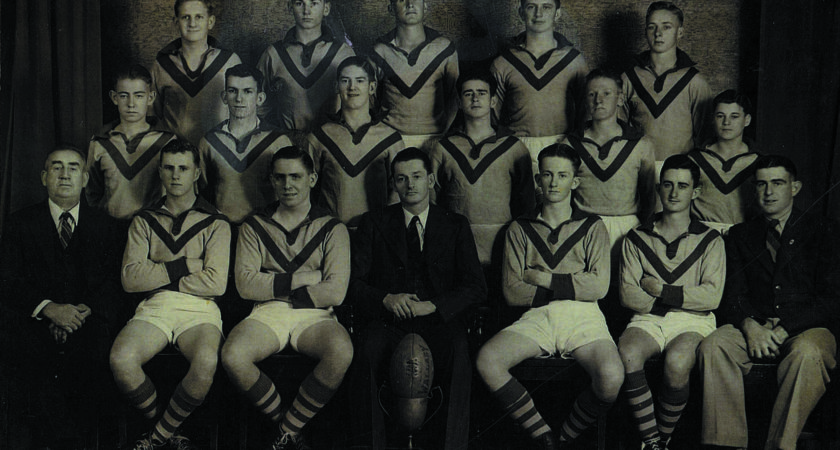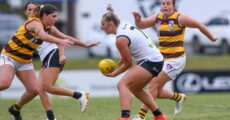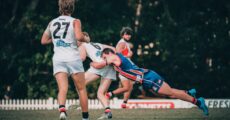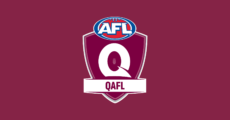The following is an excerpt from More of the Kangaroo: 150 Years of Australian Football in Queensland.
You can purchase your copy of the book here.
More of the Kangaroo will be officially launched on December 11 at Coorparoo AFC. Find out more information here.
Having originally established its Naval Supply Depot on the Brisbane River at New Farm Wharf in a location close to its Submarine Repair Unit, the United States Navy found it necessary to move the depot as the base expanded. With Perry Park considered an excellent location for the supply depot, some facilities were moved there while others went to Newstead Wharf. Quarters for enlisted personnel, a large administration building and sizable warehouses with loading docks were built in the park. Stores numbered 1 to 5 were constructed by the end of 1943, and a number of smaller buildings were also built during the war.
For part of 1942, the code’s other main ground, Windsor Park, was one of several Brisbane locations used as heavy artillery sites and as a result it too was temporarily lost to the League. By the start of 1943, the League reported that although Perry Park was in a “disgraceful condition”, the reassurance was given that “council officials state that [both] grounds will be restored to good condition by the authorities.” While Windsor Park would only miss one season of football, the return to Perry Park would take much longer. Col Hoy offered his recollections of the state of Perry Park during the war years:
The Americans had Perry’s and for about the first year it was quite ludicrous to see the playing area covered by trucks in their motor pool, and right in the centre looking lonely and forlorn, overgrown by weeds and surrounded by barbed wire, the cricket pitch. There was also a row about the Commonwealth sheds built during the war and these had encroached on the area surrounding the playing arena.
With the two main ovals taken over by the military authorities, arrangements were made for the use of the hockey grounds at Victoria Park, situated near the RNA (Exhibition) Showgrounds. This provided the League with two excellent ovals that were convenient to the city, averting the problem of players losing interest by having to travel long distances to play on poor grounds. The grounds at Victoria Park were closely mown and of good size for play at 186 and 164 yards long.
The League’s priorities were indicative of the difficult time. The general consensus in the country was that, while organised sport should continue, it should be conducted in a manner which prevented any interruption to military training or production. Regarding the League’s plans for the season, League secretary Jim Nixon said:
Whatever is done will have for its object the future of young players and schoolboys. Big football in these critical days is out of the question but the physical fitness of our youth must be looked after.
As the Second 18 competition (which of course by this stage was dormant) had done in 1940, the seniors moved to fourteen players a side as a way to combat the wartime reduction in playing numbers. This practice remained in effect up to and including the 1946 season. Either the forward and back pockets or the half-forward and half-back flanks were sacrificed in order that the game could go on. The schools competition went into recess from 1942 to 1944. Indicative of the heightened tension of the time, the Under 15 competition was abandoned as parents would not allow their boys to travel across the city.
Across the country a rigorous debate emerged as to the appropriateness of playing sport on Sundays. Troops on leave on Sundays could number in the hundreds or thousands in Brisbane, and it was commonplace to see many young men in uniform roaming the streets in search of recreation. With the resultant desire to keep the troops entertained and relaxed, the playing of fixtures in the various football codes on Sundays was firmly on the agenda. The League, who had only previously played games on Saturdays and public holidays, expressed its opposition to the proposal to play premiership matches on Sundays. This view was supported by the Queensland Rugby Union and Brisbane Rugby League with respect to their own competitions.
However, with a long history of engaging the armed forces in one-off matches, in particular games against visiting naval personnel, the League embraced the idea that servicemen themselves participate in Sunday games, either against each other or against local teams. Jim Nixon was aware that many southern players of high repute were stationed in Brisbane, and agreed to arrange matches between troops if the grounds at Victoria Park could be secured on Sundays.
Everyone was not in favour, however. The concept of Sunday sports received condemnation and some in the Church were especially critical of the idea. The Courier-Mail reported the concerns of the President of the Queensland Baptist Union, Rev. A. H. Brooks, who was vocal in his opposition. He felt that:
The opening of football fields, theatres, dance halls on Sundays was an infringement of the laws of God and a disgrace to the country. The Prime Minister might have power, under the National Security Regulations, to sanction Sunday entertainments, but those laws were overridden by the laws of God. Mr. Curtin dare not ignore those laws, otherwise the nation would be placed in dire peril.
Despite the opposing voices, 1942 saw the introduction of a variety of sports played on Sundays by troops. A series of high-standard Australian rules games throughout the season each featured at least one team of military personnel. One of the early games saw an Army team featuring Essendon’s Ivor McIvor and Geelong’s Ron Sceney beat a Navy team. Two weeks later the same two players were part of a Victorian Army team which was beaten by a Western Australian Army team. Similar matches continued until the end of September with teams such as Machine Gunners, Army Transport, Headquarters, Signals, Victorian A.I.F. and Victorian Militia also making appearances. A Brisbane representative team featured in some of the matches. Further details on these games can be found in the Extracurricular Games section of the book (Part 6).
Past State Commercial High withdrew from the competition and Coorparoo were forced into abeyance. As had been planned in 1941, Taringa became known as ‘Western Districts’ and continued to play in their maroon jerseys.
Eighteen rounds were played, each of the four sides playing each other six times. A late-season decision by the League saw the Page-McIntyre final four system replaced for this one season by a shorter system of two knockout Semi-Finals and a Grand Final. The aim of the move was to shorten the season in order to give servicemen extra time to take part in their own matches. Perhaps mimicking the Page-McIntyre system of having the first-placed team play the second and the third play the fourth in the Semi-Finals was not properly thought through, but that was how things panned out nonetheless. Ironically, the First Semi-Final resulted in a draw with the necessary replay putting the Grand Final back by a week anyway.
After the first four rounds of the season were played at Melrose Park, the Domain and Toowong Sports Ground, Victoria Park No. 1 and No. 2 grounds became available. From Round 5, all premiership games were played at the new venue, although a couple of the military matches were played at the Exhibition Ground late in the season.
Col Hoy recalled the problem of charging admission by not having an enclosed ground:
The Council then frowned on “gate takings” at an open ground and the indefatigable secretary, Jim Nixon, risked jail by sneaking around with a box under his coat. Fortunately the troops did not have too many “death adders” in their uniforms and things were not too bad. Kedron was [at] Melrose Park in those days, and they had the same problems moneywise.
The season was one of the most even on record. Western Districts won their first four games before a mid-season slump saw them lose six in a row, ultimately finishing third on the ladder. 15-year-old Cecil Morrison burst onto the scene with five of his team’s seven goals in a Round 1 win over Windsor. In Round 6 the maroons kicked an astonishing 11.1 (67) in beating Kedron.
While no side stood out, Kedron and Mayne did enough to claim the top two spots on the ladder. Kedron’s Alan Gourlay was a fast, clever player who showed fine form and kicked some excellent goals. Teammate Erwin Dornau continued to shine while four goals were kicked for Kedron by another promising youngster named Col Taylor in a victory over Windsor. The ruggedness of veterans Len Gregory and Mick Byrne was proving an asset for Mayne, as was the play of Harold Humphries and Mathers.
Mayne defender Harold Humphries (Rod and Glenda Barber)
Many years later Col Taylor highlighted the problem that Erwin Dornau posed for opposing teams. Mick Byrne reportedly instructed his troops “Keep the bloody ball away from Dornau” to which came the exasperated reply “We can’t – the bastard’s everywhere.”
The teams frequently took the opportunity to strengthen their line-up with the inclusion of servicemen. B. Moore (Oakleigh), J. Kennedy (South Melbourne) and L. Buchanan (R.A.A.F. and Prahran) turned out for Western Districts. K. Galvin (Elsternwick), Morey (A.I.F. Mildura) appeared for Mayne. Windsor’s first win for the season came in Round 7 when they included five southerners – J. McKay, M. Chivers and R. Gee of the Navy and R. and K. McLean of the Army. Later in the season A.I.F. men Dalton, Barrand (A.I.F. Bolar Bay) and N. Stevens (A.I.F. Henty) shone for the green-and-whites in a narrow loss to Kedron. The officials were also represented when Victorian umpire R. P. Moore, who was with the A.I.F., took the whistle for the Wests-Mayne game in Round 8.
Windsor struggled for most of the season, winning just two of their first twelve games. Champion Dick Parton, by now with the A.I.F., wasn’t able to play every game owing to military duties. There was mid-season talk among the football community that the mighty club should even be disbanded and its players allotted to other teams. Aggrieved club officials consequently made a tremendous effort to keep their team on the field. The results paid dividends when the green-and-whites won three games in a row, convincingly beating each of the other three teams to regain lost respect.
Finals
Both Semi-Finals were played on the same afternoon – one on each of the two Victoria Park grounds. Although Windsor claimed the wooden spoon, it was still possible for them to win the premiership by virtue of the fact there were only the four teams. And with two knockout Semi-Finals in place, a single win would put them in the Grand Final. Having drawn with their Semi-Final opponents, Wests, in Round 16, the game loomed as a close battle. Windsor came from seventeen points behind at the final change to incredibly snatch a second draw with the maroons within just a few weeks. The result necessitated a replay a week later.
In the other Semi Mayne became the first team to make the Grand Final with an 18-point win over Kedron. Mayne’s best were the Burgess brothers, Jack Partridge and Mick Byrne. Minor premiers Kedron, who may have felt slightly aggrieved at the way the finals system conspired to end their season so quickly, were best served by Ted Pascoe, Col Taylor and Alan Gourlay.
In the replayed Semi, Wests nearly kicked themselves out of it. In the third thriller between the two teams in less than a month, a brilliant final quarter concluded with Wests four points to the good, albeit with the unflattering score of 3.15 (33). The two fullbacks, Alan Sanders for Wests and Huntley for Windsor, played great games. History shows that wooden spooners Windsor had been one point from making the Grand Final a week earlier.
After kicking with the wind in the Grand Final and holding Wests scoreless in the first quarter, Mayne went on to record a comfortable nineteen-point win to secure their seventh premiership. The Tigers’ comeback to the top flight after years in self-imposed exile was complete.
Bruce Pie Cup
The Bruce Pie Cup would again be awarded to the team who led the premiership after one complete round of fixtures. Western Districts won the trophy by virtue of being undefeated at that stage of the season. After withdrawing from the premiership late in 1941 when named Taringa, the club fostered their junior talent and the policy reaped an early reward. The cup would not be awarded from 1943 to 1946.
1942
TEAM P W D L PTS
Kedron 17 11 – 6 44
Mayne 17 10 – 7 40
Western Districts 18 8 1 9 34
Windsor 18 5 1 12 22
The result of one Kedron-Mayne game is not to hand; the game may not have been played.
First Semi-Final, Saturday 5 September
- Districts 8.12 (60) drew with Windsor 9.6 (60) Victoria Pk
First Semi-Final Replay, Saturday 12 September
Western Districts 3.15 (33) d Windsor 4.5 (29) Victoria Pk
Second Semi-Final, Saturday 5 September
Mayne 6.10 (46) d Kedron 4.4 (28) Victoria Pk
Grand Final, Saturday 19 September
Mayne 8.9 (57) d Western Districts 5.8 (38) Victoria Pk
